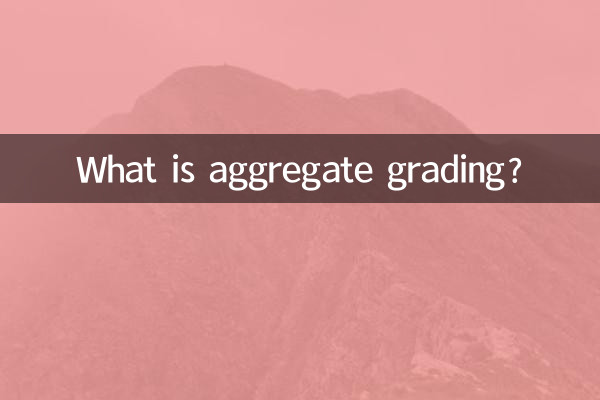What is aggregate grading?
Grading of aggregates is a crucial concept in construction engineering and concrete preparation. It directly affects the strength, durability and workability of concrete. This article will introduce the grading of aggregates in detail, including its definition, importance, classification and related technical parameters.
1. Definition of aggregate gradation

The gradation of aggregate refers to the distribution of particles of different sizes in the aggregate. Through scientific and reasonable gradation design, the packing density of aggregates can be optimized, the void ratio can be reduced, and the performance of concrete can be improved. Well-graded aggregates can improve the density of concrete, reduce cement consumption, and save costs.
2. The importance of aggregate gradation
The gradation of aggregates has many effects on the performance of concrete:
1.strength: Reasonable grading can improve the density of concrete, thereby enhancing its compressive and flexural strength.
2.Workability: Good gradation makes concrete easier to mix, transport and pour, reducing the risk of segregation and bleeding.
3.Durability: Reasonably graded aggregates can reduce pores in concrete and improve frost resistance and impermeability.
4.Economy: By optimizing the gradation, the cement consumption can be reduced and the project cost can be reduced.
3. Classification of aggregate gradation
According to the distribution of aggregate particle size, gradation can be divided into the following categories:
| Grading type | describe | Features |
|---|---|---|
| continuous grading | Continuous distribution of particles from the largest particle size to the smallest particle size | High density and good workability |
| discontinuous grading | Missing particles of some intermediate sizes | Need to be used with other materials |
| Single particle level | Aggregate particle size is concentrated within a narrow range | Suitable for special engineering needs |
4. Technical parameters of aggregate gradation
In order to quantify the gradation of aggregates, the following technical parameters are usually used:
| Parameter name | Calculation formula | significance |
|---|---|---|
| Fineness modulus | FM = (sum of cumulative screening percentage) / 100 | Reflects the thickness of the aggregate |
| Uneven coefficient | Cu=D60/D10 | Indicates the uniformity of particle size distribution |
| Curvature coefficient | Cc = (D30)² / (D10 × D60) | Reflects the smoothness of the grading curve |
5. Design method of aggregate gradation
In actual engineering, the design of aggregate gradation usually follows the following steps:
1.Determine the maximum particle size of aggregate: Select the appropriate coarsest aggregate according to the structure size and spacing of steel bars.
2.Select grading type: Select continuous grading or discontinuous grading according to project requirements.
3.Perform screening tests: Determine the particle size distribution of aggregates by standard sieve analysis.
4.Adjust the mix ratio: Adjust the proportion of thick and fine aggregate according to the test results and optimize the grading curve.
6. Common problems and solutions for aggregate grading
| question | reason | solution |
|---|---|---|
| concrete segregation | Unreasonable grading, too much coarse aggregate | Increase the proportion of fine aggregate |
| Poor workability | Insufficient fine aggregate | Supplement 0.15-0.6mm particle size particles |
| Insufficient strength | The void ratio is too large | Optimize grading curve and reduce gaps |
7. Development Trend of Aggregate Grading
With the advancement of construction technology, the research on aggregate gradation has also shown new development trends:
1.computer aided design: Use numerical simulation technology to optimize the grading curve.
2.Recycled aggregate applications: Study the grading characteristics of recycled aggregates and their impact on concrete properties.
3.high performance concrete: Development of special gradings suitable for ultra-high performance concrete.
4.sustainability: Explore graded design options to reduce natural resource consumption.
In summary, the gradation of aggregates is a key factor in concrete technology. Through scientific gradation design and strict quality control, the performance of concrete can be significantly improved to meet the needs of various projects. With the continuous development of technology, the research on aggregate gradation will bring more innovations and breakthroughs to the construction industry.

check the details

check the details